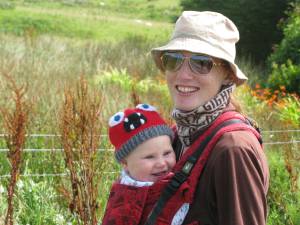
This is the latest post in a series of blogs that I’ve written about some research I did on slings back in 2017 (yes, I know it’s been a while in coming but that’s part-time academic life for you, I’m afraid – hopefully you’ll think it’s been worth waiting for!). In previous posts on this topic, I explored how slings can help with the many challenges involved in getting out and about during early family life. Really happily, I was also able to add to the growing body of academic research on the benefits of slings by publishing these results in the Mobilities journal.
Today, however, I want to pick up on a slightly broader theme which I hope will form the basis of a second academic article that I’m currently writing. In short, using slings myself and talking to others about their experiences of using slings made me reflect a lot on how we think about the relationships between parents, children and the wider community. In particular, I started thinking about how slings can be part of developing a culture that is more supportive of parents and children.
Doing this felt really important because, let’s face it, slings are sometimes criticised for doing exactly the reverse of this. Let me explain a little more… The research that I did revealed a real ambivalence around the role of physical closeness between parents and children in our society, creating a situation in which it is very hard for women, in particular to ‘win’. I think Sarah really hit the nail on the head when she said: “Some of the advice they give really conflicts with other advice they give. So on the one hand they are saying that… having them so close is such a good thing and then on the other hand they are saying, well therefore they must sleep in their… own bed.”
Indeed, when I asked parents about how others reacted to them using slings, conflicted feelings on this issue were really apparent: while some friends and family members praised the ‘cosiness’, ‘cuddles’, and closeness of the sling, others would raise concerns about clinginess and arrested development. So two widely different sets of reactions but all in response to the same thing – the physical closeness created by the sling. How can we make sense of such conflicting reactions? In looking at the interview data, I was really struck by this disconnect: almost without exception, the parents that I interviewed used slings in addition to – or occasionally instead of – prams, because they felt they made life easier for them. And yet, in wider society, there was still a very prominent assumption that carrying your baby entailed more work for the mother in particular. This was often voiced in comments like ‘isn’t he heavy?’ or ‘you’re making a rod for your own back’.
In order to make sense of this apparent contradiction, I ended up having to think differently about the kinds of work involved in parenting. In particular, I needed to look closely at the role that the body plays in parenting and how slings relate to that. I’ll share my thoughts with you here but I’d also love to know what you think, so please feel free to get in touch with your ideas and feedback.
So, on one level, there’s no getting away from the fact that parenting has always been a deeply physical practice. Pregnancy, birth, (breast)feeding, rocking, patting, burping, cuddling, pushing the pram for naps and piggybacks for older children are just a few examples of the way in which our bodies get involved in parenting every single day. And yes, this can be lovely (we’ll come back to those cuddles in a future blog post!), but it can also be very hard work. It’s therefore perhaps no surprise that the many of the innovations marketed at parents are designed to reduce the physical labour involved in parenting by mediating between the body of the parent and the child (for example dummies, rockers and pushchairs)[1]. So where do slings fit in this space? Well, of course, they are a direct contradiction to that trend: carrying a child definitely represents a re-bodying of parental care work, and in a social context where it is assumed that a higher degree of physical contact equates to more work for the mother in particular, it’s easy to see how slings can seem counterintuitive. However, as I indicated previously, this is by no means a straightforward equation, since parents don’t tend to make choices that will make their lives harder! Consequently, if we really want to understand the benefits of slings, then we need to be able to explain why it is that a higher degree of physical closeness can often be less work for parents.
That’s
exactly what I’ll be doing in the next blog post where we’ll look in more
detail at the different kinds of work involved in parenting and what it is that
goes on when you actually carry your baby. No spoilers, but let’s just say
that, over the next few posts, I’ll be looking at how slings can contribute to
distributing the work of parenting to a wider range of people and things (we’ll
be talking dads, grandparents, wider society, the physical environment and even
the children themselves!). I’ll also be asking whether traditional notions of
dependence/independence are a helpful way of understanding parent-child
relationships, or whether we can do better (hint: I think we can!). Thanks for
reading and see you next time!
[1] Kabat-Zinn, M. and Kabat-Zinn, J. (1997) Everyday Blessings: The inner work of mindful parenting. Hatchett Books, New York.
